Deck 18: The Brain and the Cranial Nerves
Question
Question
Question
Question
Question
Question
Question
Question
Question
Question
Question
Question
Question
Question
Question
Question
Question
Question
Question
Question
Question
Question
Question
Question
Question
Question
Question
Question
Question
Question
Question
Question
Question
Question
Question
Question
Question
Question
Question
Question
Question
Question
Question
Question
Question
Question
Question
Question
Question
Question
Question
Question
Question
Question
Question
Question
Question
Question
Question
Question
Question
Question
Question
Question
Question
Question
Question
Question
Question
Question
Question
Question
Question
Question
Question

Unlock Deck
Sign up to unlock the cards in this deck!
Unlock Deck
Unlock Deck
1/75
Play
Full screen (f)
Deck 18: The Brain and the Cranial Nerves
1
In what lobe of the cerebrum would you find the motor speech area (Broca's area)?
A) occipital lobe
B) temporal lobe
C) parietal lobe
D) frontal lobe
A) occipital lobe
B) temporal lobe
C) parietal lobe
D) frontal lobe
D
2
Which of the following is NOT a part of the hypothalamus?
A) preoptic region
B) tuberal region
C) supraoptic region
D) intermediate mass
A) preoptic region
B) tuberal region
C) supraoptic region
D) intermediate mass
D
3
The regions of the brain stem involved in the control of respiration are the
A) medulla and pons.
B) pons and midbrain.
C) midbrain and medulla.
D) midbrain, pons, and medulla.
A) medulla and pons.
B) pons and midbrain.
C) midbrain and medulla.
D) midbrain, pons, and medulla.
A
4
The infundibulum is the anatomical link between the brain and the pituitary gland, and therefore it is the primary link between the nervous and endocrine systems. Structures contained in the infundibulum consist of which of the following?
A) a tract that transports hormones from the paraventricular and supraoptic nuclei to the posterior pituitary
B) small blood vessels that transport regulating hormones from the median eminence of the hypothalamus to the anterior pituitary
C) Both choices are correct.
D) Neither choice is correct.
A) a tract that transports hormones from the paraventricular and supraoptic nuclei to the posterior pituitary
B) small blood vessels that transport regulating hormones from the median eminence of the hypothalamus to the anterior pituitary
C) Both choices are correct.
D) Neither choice is correct.

Unlock Deck
Unlock for access to all 75 flashcards in this deck.
Unlock Deck
k this deck
5
Loss of taste in the anterior region of the tongue may be an indication of damage to which cranial nerve?
A) facial VII
B) trigeminal V
C) glossopharyngeal IX
D) vagus X
A) facial VII
B) trigeminal V
C) glossopharyngeal IX
D) vagus X

Unlock Deck
Unlock for access to all 75 flashcards in this deck.
Unlock Deck
k this deck
6
In what lobe of the cerebrum would you find the primary motor area?
A) occipital lobe
B) temporal lobe
C) parietal lobe
D) frontal lobe
A) occipital lobe
B) temporal lobe
C) parietal lobe
D) frontal lobe

Unlock Deck
Unlock for access to all 75 flashcards in this deck.
Unlock Deck
k this deck
7
Circumventricular organs in the wall of the third ventricle lack a blood-brain barrier. This enables them to
A) facilitate the circulation of cerebrospinal fluid in the ventricles.
B) monitor the chemical composition of the blood.
C) secrete cerebrospinal fluid into the ventricles.
D) all of these choices.
A) facilitate the circulation of cerebrospinal fluid in the ventricles.
B) monitor the chemical composition of the blood.
C) secrete cerebrospinal fluid into the ventricles.
D) all of these choices.

Unlock Deck
Unlock for access to all 75 flashcards in this deck.
Unlock Deck
k this deck
8
Which of the following is an incorrect statement about a feature of the medulla oblongata?
A) The inferior cerebellar peduncles are fiber tracts that connect the olives of the medulla to the cerebellum.
B) The vestibular nuclear complex is found mostly in the medulla.
C) Pyramids contain the main sensory tracts that pass through the brain stem from the spinal cord; they are visible on the dorsal surface of the medulla.
D) Vital reflex centers for control of heart rate, breathing rate, and blood pressure are located in the medulla.
A) The inferior cerebellar peduncles are fiber tracts that connect the olives of the medulla to the cerebellum.
B) The vestibular nuclear complex is found mostly in the medulla.
C) Pyramids contain the main sensory tracts that pass through the brain stem from the spinal cord; they are visible on the dorsal surface of the medulla.
D) Vital reflex centers for control of heart rate, breathing rate, and blood pressure are located in the medulla.

Unlock Deck
Unlock for access to all 75 flashcards in this deck.
Unlock Deck
k this deck
9
A midsagittal section of the brain would pass through which of the following?
A) longitudinal fissure
B) corpus callosum
C) falx cerebri
D) all of these choices
A) longitudinal fissure
B) corpus callosum
C) falx cerebri
D) all of these choices

Unlock Deck
Unlock for access to all 75 flashcards in this deck.
Unlock Deck
k this deck
10
The blood-cerebrospinal fluid barrier
A) is the same thing as the blood-brain barrier.
B) is due mainly to tight junctions between endothelial cells of the capillaries throughout the brain tissue.
C) protects the neurons of the brain and spinal cord from potentially harmful substances in the blood.
D) is another name for cranial meninges.
A) is the same thing as the blood-brain barrier.
B) is due mainly to tight junctions between endothelial cells of the capillaries throughout the brain tissue.
C) protects the neurons of the brain and spinal cord from potentially harmful substances in the blood.
D) is another name for cranial meninges.

Unlock Deck
Unlock for access to all 75 flashcards in this deck.
Unlock Deck
k this deck
11
The corpus callosum allows information to travel between cerebral hemispheres. Therefore the corpus callosum contains _____ tracts.
A) association
B) commissural
C) projection
D) all of these choices
A) association
B) commissural
C) projection
D) all of these choices

Unlock Deck
Unlock for access to all 75 flashcards in this deck.
Unlock Deck
k this deck
12
Choroid plexuses are specialized capillaries in the CNS that 1. are covered by ependymal cells.
2) are located in the walls of the ventricles.
3) are located in the dural venous sinuses.
4) are the sites for reabsorption of CSF.
5) are derived from the arachnoid layer of the meninges.
A) 3, 4, 5
B) 1, 2, 4, 5
C) 1, 2
D) 2, 3, 4
2) are located in the walls of the ventricles.
3) are located in the dural venous sinuses.
4) are the sites for reabsorption of CSF.
5) are derived from the arachnoid layer of the meninges.
A) 3, 4, 5
B) 1, 2, 4, 5
C) 1, 2
D) 2, 3, 4

Unlock Deck
Unlock for access to all 75 flashcards in this deck.
Unlock Deck
k this deck
13
In what lobe of the cerebrum would you find the primary visual area?
A) occipital lobe
B) temporal lobe
C) parietal lobe
D) frontal lobe
A) occipital lobe
B) temporal lobe
C) parietal lobe
D) frontal lobe

Unlock Deck
Unlock for access to all 75 flashcards in this deck.
Unlock Deck
k this deck
14
A block of which nerve would provide anesthesia to the lower teeth and chin?
A) maxillary branch of cranial nerve V
B) mandibular branch of the trigeminal nerve
C) glossopharyngeal nerve (IX)
D) cranial nerve VII
A) maxillary branch of cranial nerve V
B) mandibular branch of the trigeminal nerve
C) glossopharyngeal nerve (IX)
D) cranial nerve VII

Unlock Deck
Unlock for access to all 75 flashcards in this deck.
Unlock Deck
k this deck
15
The tectum of the midbrain bears four rounded elevations
A) called substantia nigra.
B) that control all subconscious muscle activities.
C) that transmit all sensory and motor information between the upper and lower brain regions.
D) that control reflex movements in response to visual and auditory stimuli.
A) called substantia nigra.
B) that control all subconscious muscle activities.
C) that transmit all sensory and motor information between the upper and lower brain regions.
D) that control reflex movements in response to visual and auditory stimuli.

Unlock Deck
Unlock for access to all 75 flashcards in this deck.
Unlock Deck
k this deck
16
The cerebellar peduncles conduct information into and out of the cerebellum. The correct statement is
A) the superior cerebellar peduncles conduct only sensory information.
B) the inferior cerebellar peduncles contain only motor fibers.
C) the middle cerebellar peduncles contain only afferent (sensory) fibers.
D) none of these choices.
A) the superior cerebellar peduncles conduct only sensory information.
B) the inferior cerebellar peduncles contain only motor fibers.
C) the middle cerebellar peduncles contain only afferent (sensory) fibers.
D) none of these choices.

Unlock Deck
Unlock for access to all 75 flashcards in this deck.
Unlock Deck
k this deck
17
The postcentral gyrus is in the _____ lobe of the cortex; it contains the primary _____ area.
A) parietal, somatosensory
B) parietal, motor
C) frontal, somatosensory
D) frontal, motor
A) parietal, somatosensory
B) parietal, motor
C) frontal, somatosensory
D) frontal, motor

Unlock Deck
Unlock for access to all 75 flashcards in this deck.
Unlock Deck
k this deck
18
Which of the following statements about the basal nuclei is/are TRUE?
A) The caudate nucleus consists of the globus pallidus and the putamen.
B) The corpus striatum consists of the caudate nucleus and the lentiform nucleus.
C) The putamen and caudate nucleus regulate muscle tone required for specific movements
D) all of these choices.
A) The caudate nucleus consists of the globus pallidus and the putamen.
B) The corpus striatum consists of the caudate nucleus and the lentiform nucleus.
C) The putamen and caudate nucleus regulate muscle tone required for specific movements
D) all of these choices.

Unlock Deck
Unlock for access to all 75 flashcards in this deck.
Unlock Deck
k this deck
19
Inability to control eyeball movement may indicate damage to which cranial nerve(s)? 1. trochlear IV
2) optic II
3) oculomotor III
4) trigeminal V
5) abducens VI
A) 1, 2, 3, 4, 5
B) 2, 3, 4, 5
C) 1, 2, 4
D) 1, 3, 5
2) optic II
3) oculomotor III
4) trigeminal V
5) abducens VI
A) 1, 2, 3, 4, 5
B) 2, 3, 4, 5
C) 1, 2, 4
D) 1, 3, 5

Unlock Deck
Unlock for access to all 75 flashcards in this deck.
Unlock Deck
k this deck
20
Which of the following is NOT an extension of the dura mater?
A) falx cerebelli
B) falx cerebri
C) tentorium cerebelli
D) epidural space
A) falx cerebelli
B) falx cerebri
C) tentorium cerebelli
D) epidural space

Unlock Deck
Unlock for access to all 75 flashcards in this deck.
Unlock Deck
k this deck
21
Which is a function of the trigeminal (V) nerve?
A) conveys sensory impulses from the facial region and anterior scalp
B) turns eyeball laterally via lateral rectus muscle
C) causes movement of eyelid and eyeball; constriction of pupil
D) causes movement of eyeball via superior oblique muscle
A) conveys sensory impulses from the facial region and anterior scalp
B) turns eyeball laterally via lateral rectus muscle
C) causes movement of eyelid and eyeball; constriction of pupil
D) causes movement of eyeball via superior oblique muscle

Unlock Deck
Unlock for access to all 75 flashcards in this deck.
Unlock Deck
k this deck
22
In what part of the brain would you find the cerebral peduncles?
A) midbrain
B) medulla oblongata
C) hypothalamus
D) cerebrum
A) midbrain
B) medulla oblongata
C) hypothalamus
D) cerebrum

Unlock Deck
Unlock for access to all 75 flashcards in this deck.
Unlock Deck
k this deck
23
Which is a function of the glossopharyngeal (IX) nerve?
A) conveys impulses from taste buds on the posterior one-third of the tongue
B) conveys impulses to visceral, cardiac, and skeletal muscles
C) conveys motor impulses to laryngeal and pharyngeal muscles, and to the sternocleidomastoid and trapezius muscles
D) controls movement of the tongue during speech and swallowing
A) conveys impulses from taste buds on the posterior one-third of the tongue
B) conveys impulses to visceral, cardiac, and skeletal muscles
C) conveys motor impulses to laryngeal and pharyngeal muscles, and to the sternocleidomastoid and trapezius muscles
D) controls movement of the tongue during speech and swallowing

Unlock Deck
Unlock for access to all 75 flashcards in this deck.
Unlock Deck
k this deck
24
In what part of the brain would you find the hippocampus?
A) thalamus
B) limbic system
C) hypothalamus
D) cerebellum
A) thalamus
B) limbic system
C) hypothalamus
D) cerebellum

Unlock Deck
Unlock for access to all 75 flashcards in this deck.
Unlock Deck
k this deck
25
Which is a function of the abducens (VI) nerve?
A) conveys sensory impulses from the facial region and anterior scalp
B) turns eyeball medially via medial rectus muscle
C) causes movement of eyelid and eyeball, constriction of pupil
D) causes movement of eyeball via lateral rectus muscle
A) conveys sensory impulses from the facial region and anterior scalp
B) turns eyeball medially via medial rectus muscle
C) causes movement of eyelid and eyeball, constriction of pupil
D) causes movement of eyeball via lateral rectus muscle

Unlock Deck
Unlock for access to all 75 flashcards in this deck.
Unlock Deck
k this deck
26
Oxygen, carbon dioxide, glucose, and most anesthetics readily pass through the blood-brain barrier.

Unlock Deck
Unlock for access to all 75 flashcards in this deck.
Unlock Deck
k this deck
27
Pigmented nuclei in the midbrain called substantia nigra control subconscious muscle activities.

Unlock Deck
Unlock for access to all 75 flashcards in this deck.
Unlock Deck
k this deck
28
Which is a function of the vagus (X) nerve?
A) conveys impulses from taste buds on the posterior one-third of the tongue
B) conveys impulses to visceral, cardiac, and skeletal muscles
C) conveys motor impulses to laryngeal and pharyngeal muscles, and to the sternocleidomastoid and trapezius muscles
D) controls movement of the tongue during speech and swallowing
A) conveys impulses from taste buds on the posterior one-third of the tongue
B) conveys impulses to visceral, cardiac, and skeletal muscles
C) conveys motor impulses to laryngeal and pharyngeal muscles, and to the sternocleidomastoid and trapezius muscles
D) controls movement of the tongue during speech and swallowing

Unlock Deck
Unlock for access to all 75 flashcards in this deck.
Unlock Deck
k this deck
29
In what part of the brain would you find the oval shaped swellings called olives?
A) midbrain
B) medulla oblongata
C) hypothalamus
D) cerebrum
A) midbrain
B) medulla oblongata
C) hypothalamus
D) cerebrum

Unlock Deck
Unlock for access to all 75 flashcards in this deck.
Unlock Deck
k this deck
30
In what part of the brain would you find the medial and lateral geniculate nuclei?
A) thalamus
B) medulla oblongata
C) hypothalamus
D) cerebrum
A) thalamus
B) medulla oblongata
C) hypothalamus
D) cerebrum

Unlock Deck
Unlock for access to all 75 flashcards in this deck.
Unlock Deck
k this deck
31
In what part of the brain would you find the corpus striatum?
A) midbrain
B) medulla oblongata
C) hypothalamus
D) cerebrum
A) midbrain
B) medulla oblongata
C) hypothalamus
D) cerebrum

Unlock Deck
Unlock for access to all 75 flashcards in this deck.
Unlock Deck
k this deck
32
Which is a function of the hypoglossal (XII) nerve?
A) conveys impulses from taste buds on the posterior one-third of the tongue
B) conveys impulses to visceral, cardiac, and skeletal muscles
C) conveys motor impulses to laryngeal and pharyngeal muscles, and to the sternocleidomastoid and trapezius muscles
D) controls movement of the tongue during speech and swallowing
A) conveys impulses from taste buds on the posterior one-third of the tongue
B) conveys impulses to visceral, cardiac, and skeletal muscles
C) conveys motor impulses to laryngeal and pharyngeal muscles, and to the sternocleidomastoid and trapezius muscles
D) controls movement of the tongue during speech and swallowing

Unlock Deck
Unlock for access to all 75 flashcards in this deck.
Unlock Deck
k this deck
33
Which is a function of the accessory (XI) nerve?
A) conveys impulses from taste buds on the posterior one-third of the tongue
B) conveys impulses to visceral, cardiac, and skeletal muscles
C) conveys motor impulses to the sternocleidomastoid and trapezius muscles
D) controls movement of the tongue during speech and swallowing
A) conveys impulses from taste buds on the posterior one-third of the tongue
B) conveys impulses to visceral, cardiac, and skeletal muscles
C) conveys motor impulses to the sternocleidomastoid and trapezius muscles
D) controls movement of the tongue during speech and swallowing

Unlock Deck
Unlock for access to all 75 flashcards in this deck.
Unlock Deck
k this deck
34
Which is a function of the olfactory (I) nerve?
A) conveys nerve impulses related to smell
B) conveys nerve impulses related to vision
C) causes movement of eyelid and eyeball; constriction of pupil
D) causes movement of eyeball via superior oblique muscle
A) conveys nerve impulses related to smell
B) conveys nerve impulses related to vision
C) causes movement of eyelid and eyeball; constriction of pupil
D) causes movement of eyeball via superior oblique muscle

Unlock Deck
Unlock for access to all 75 flashcards in this deck.
Unlock Deck
k this deck
35
In what lobe of the cerebrum would you find the primary auditory area?
A) occipital lobe
B) temporal lobe
C) parietal lobe
D) frontal lobe
A) occipital lobe
B) temporal lobe
C) parietal lobe
D) frontal lobe

Unlock Deck
Unlock for access to all 75 flashcards in this deck.
Unlock Deck
k this deck
36
In what part of the brain would you find the insula?
A) thalamus
B) medulla oblongata
C) hypothalamus
D) cerebrum
A) thalamus
B) medulla oblongata
C) hypothalamus
D) cerebrum

Unlock Deck
Unlock for access to all 75 flashcards in this deck.
Unlock Deck
k this deck
37
In what part of the brain would you find the arbor vitae?
A) thalamus
B) limbic system
C) cerebellum
D) pons
A) thalamus
B) limbic system
C) cerebellum
D) pons

Unlock Deck
Unlock for access to all 75 flashcards in this deck.
Unlock Deck
k this deck
38
Which is a function of the facial (VII) nerve?
A) conveys nerve impulses related to smell
B) turns eyeball laterally via lateral rectus muscle
C) conveys impulses from the taste buds on the anterior two-thirds of the tongue
D) conveys impulses associated with hearing and equilibrium
A) conveys nerve impulses related to smell
B) turns eyeball laterally via lateral rectus muscle
C) conveys impulses from the taste buds on the anterior two-thirds of the tongue
D) conveys impulses associated with hearing and equilibrium

Unlock Deck
Unlock for access to all 75 flashcards in this deck.
Unlock Deck
k this deck
39
Which is a function of the vestibulocochlear (VIII) nerve?
A) conveys sensory impulses from the facial region and anterior scalp
B) turns eyeball laterally via lateral rectus muscle
C) conveys impulses from the taste buds on the anterior two-thirds of the tongue
D) conveys impulses associated with hearing and equilibrium
A) conveys sensory impulses from the facial region and anterior scalp
B) turns eyeball laterally via lateral rectus muscle
C) conveys impulses from the taste buds on the anterior two-thirds of the tongue
D) conveys impulses associated with hearing and equilibrium

Unlock Deck
Unlock for access to all 75 flashcards in this deck.
Unlock Deck
k this deck
40
Small openings in the roof of the third ventricle allow passage of CSF into the subarachnoid space.

Unlock Deck
Unlock for access to all 75 flashcards in this deck.
Unlock Deck
k this deck
41
List the secondary brain vesicles and state which parts of the brain develop from each.

Unlock Deck
Unlock for access to all 75 flashcards in this deck.
Unlock Deck
k this deck
42
Describe the route traveled by cerebrospinal fluid from production until it is reabsorbed into venous blood.

Unlock Deck
Unlock for access to all 75 flashcards in this deck.
Unlock Deck
k this deck
43
Discuss the location of cerebrospinal fluid (CSF) in relation to the basic functions of CSF; i.e., how does location facilitate function?

Unlock Deck
Unlock for access to all 75 flashcards in this deck.
Unlock Deck
k this deck
44
The structure indicated by the arrow is the _____. 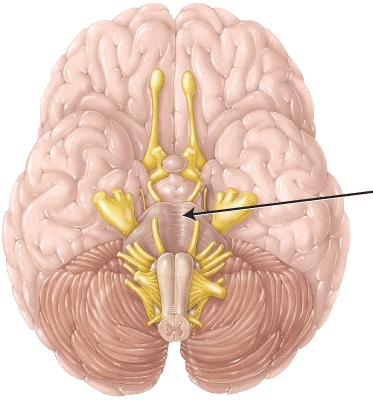
A) pons
B) midbrain
C) thalamus
D) medulla oblongata

A) pons
B) midbrain
C) thalamus
D) medulla oblongata

Unlock Deck
Unlock for access to all 75 flashcards in this deck.
Unlock Deck
k this deck
45
The pineal gland is attached to the hypothalamus by the infundibulum.

Unlock Deck
Unlock for access to all 75 flashcards in this deck.
Unlock Deck
k this deck
46
Which of the following is NOT a branch of the trigeminal (V) nerve?
A) mandibular
B) ophthalmic
C) temporal
D) maxillary
A) mandibular
B) ophthalmic
C) temporal
D) maxillary

Unlock Deck
Unlock for access to all 75 flashcards in this deck.
Unlock Deck
k this deck
47
Describe the blood-brain barrier and explain how it controls the movement of substances between the blood and brain tissue. Give examples of substances that readily cross the BBB.

Unlock Deck
Unlock for access to all 75 flashcards in this deck.
Unlock Deck
k this deck
48
List, in order from anterior to posterior, the 12 pairs of cranial nerves. Indicate whether each is sensory, motor, or mixed in function. State a main function for each nerve.

Unlock Deck
Unlock for access to all 75 flashcards in this deck.
Unlock Deck
k this deck
49
The cranial nerve which conveys parasympathetic control of most organs of the thoracic and abdominal cavities is
A) accessory (XI) nerve
B) glossopharyngeal (IX) nerve
C) facial (VII) nerve
D) vagus (X) nerve
A) accessory (XI) nerve
B) glossopharyngeal (IX) nerve
C) facial (VII) nerve
D) vagus (X) nerve

Unlock Deck
Unlock for access to all 75 flashcards in this deck.
Unlock Deck
k this deck
50
The transverse fissure separates the cerebrum from the cerebellum.

Unlock Deck
Unlock for access to all 75 flashcards in this deck.
Unlock Deck
k this deck
51
A broad region where gray matter and white matter show a netlike arrangement in the brain stem and the inferior part of the diencephalon, and whose function is to influence muscle tone and to cause arousal from sleep are collectively referred to as the
A) reticular formation
B) medial lemniscus
C) cerebral peduncles
D) cerebellar peduncles
A) reticular formation
B) medial lemniscus
C) cerebral peduncles
D) cerebellar peduncles

Unlock Deck
Unlock for access to all 75 flashcards in this deck.
Unlock Deck
k this deck
52
The structure indicated by the arrow 
A) is where the rubrospinal tract begins.
B) is where the corticospinal tract decussates.
C) is where the spinothalamic tract crosses.
D) is where third-order neurons of the posterior (dorsal) column tract originate.

A) is where the rubrospinal tract begins.
B) is where the corticospinal tract decussates.
C) is where the spinothalamic tract crosses.
D) is where third-order neurons of the posterior (dorsal) column tract originate.

Unlock Deck
Unlock for access to all 75 flashcards in this deck.
Unlock Deck
k this deck
53
This structure arises from the _____.] ![<strong>This structure arises from the _____.] </strong> A) telencephalon. B) mesencephalon. C) metencephalon. D) diencephalon.](https://d2lvgg3v3hfg70.cloudfront.net/TB7892/11eae20c_3fd2_8eef_ad0d_319159d713cf_TB7892_00.jpg)
A) telencephalon.
B) mesencephalon.
C) metencephalon.
D) diencephalon.
![<strong>This structure arises from the _____.] </strong> A) telencephalon. B) mesencephalon. C) metencephalon. D) diencephalon.](https://d2lvgg3v3hfg70.cloudfront.net/TB7892/11eae20c_3fd2_8eef_ad0d_319159d713cf_TB7892_00.jpg)
A) telencephalon.
B) mesencephalon.
C) metencephalon.
D) diencephalon.

Unlock Deck
Unlock for access to all 75 flashcards in this deck.
Unlock Deck
k this deck
54
All cranial nerves are mixed nerves.

Unlock Deck
Unlock for access to all 75 flashcards in this deck.
Unlock Deck
k this deck
55
The lateral cerebral sulcus primarily separates the temporal lobe from the parietal lobe.

Unlock Deck
Unlock for access to all 75 flashcards in this deck.
Unlock Deck
k this deck
56
Which of the following is incorrectly matched regarding the midbrain?
A) Inferior colliculi; reflex centers for sudden movements of the head and trunk in response to auditory stimuli
B) Superior colliculi; reflex centers for movements of the eyes, head and neck in response to visual stimuli
C) Red nucleus; origin of the tectospinal tract
D) Substantia nigra; production of the neurotransmitter dopamine
A) Inferior colliculi; reflex centers for sudden movements of the head and trunk in response to auditory stimuli
B) Superior colliculi; reflex centers for movements of the eyes, head and neck in response to visual stimuli
C) Red nucleus; origin of the tectospinal tract
D) Substantia nigra; production of the neurotransmitter dopamine

Unlock Deck
Unlock for access to all 75 flashcards in this deck.
Unlock Deck
k this deck
57
The hypothalamic mammillary bodies serve as relay stations for reflexes related to the sense of smell.

Unlock Deck
Unlock for access to all 75 flashcards in this deck.
Unlock Deck
k this deck
58
The structure indicated by the arrow is involved with which function? 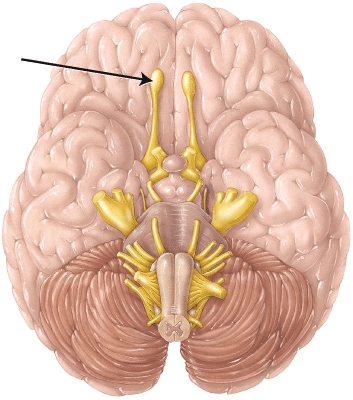
A) vision
B) hearing
C) taste
D) smell

A) vision
B) hearing
C) taste
D) smell

Unlock Deck
Unlock for access to all 75 flashcards in this deck.
Unlock Deck
k this deck
59
List the four main regions of the hypothalamus. Name the nuclei located in each region.

Unlock Deck
Unlock for access to all 75 flashcards in this deck.
Unlock Deck
k this deck
60
Which lobe(s) of the cerebellum controls subconscious movement of skeletal muscles?
A) anterior and posterior
B) flocculonodular
C) anterior and flocculonodular
D) posterior and flocculonodular
A) anterior and posterior
B) flocculonodular
C) anterior and flocculonodular
D) posterior and flocculonodular

Unlock Deck
Unlock for access to all 75 flashcards in this deck.
Unlock Deck
k this deck
61
The structure indicated by the arrow is primarily involved in vision. 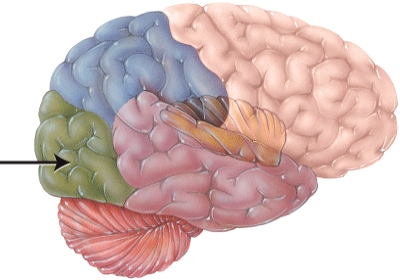


Unlock Deck
Unlock for access to all 75 flashcards in this deck.
Unlock Deck
k this deck
62
Loss of cholinergic neurons (release ACh), and the presence of beta-amyloid plaques and neurofibrillary tangles are the hallmark features of what disease?
A) Alzheimer's disease
B) Cerebral Palsy
C) Epilepsy
D) TIA
A) Alzheimer's disease
B) Cerebral Palsy
C) Epilepsy
D) TIA

Unlock Deck
Unlock for access to all 75 flashcards in this deck.
Unlock Deck
k this deck
63
During development, most of the protective structures of the brain, that is, most of the bones of the skull, associated connective tissues, and meningeal membranes arise from
A) the neural crest.
B) the neural tube.
C) the diencephalons.
D) the rhombencephalon.
A) the neural crest.
B) the neural tube.
C) the diencephalons.
D) the rhombencephalon.

Unlock Deck
Unlock for access to all 75 flashcards in this deck.
Unlock Deck
k this deck
64
This structure separates what two cerebral lobes? 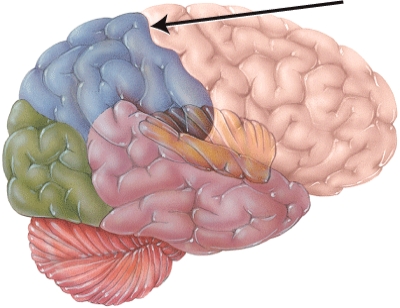
A) temporal and parietal
B) frontal and parietal
C) temporal and occipital
D) occipital and parietal

A) temporal and parietal
B) frontal and parietal
C) temporal and occipital
D) occipital and parietal

Unlock Deck
Unlock for access to all 75 flashcards in this deck.
Unlock Deck
k this deck
65
The Reticular Activating System receives input from ALL of the following types of stimuli except
A) visual.
B) auditory.
C) smell.
D) pain.
A) visual.
B) auditory.
C) smell.
D) pain.

Unlock Deck
Unlock for access to all 75 flashcards in this deck.
Unlock Deck
k this deck
66
The structure indicated by the arrow is the 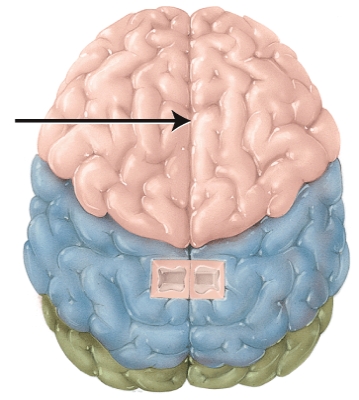
A) Central sulcus
B) Lateral sulcus
C) Transverse fissure
D) Longitudinal fissure

A) Central sulcus
B) Lateral sulcus
C) Transverse fissure
D) Longitudinal fissure

Unlock Deck
Unlock for access to all 75 flashcards in this deck.
Unlock Deck
k this deck
67
This structure is separated from the frontal lobe by the 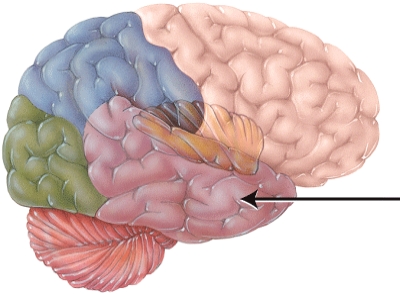
A) central sulcus.
B) falx cerebri.
C) lateral cerebral sulcus.
D) transverse fissure.

A) central sulcus.
B) falx cerebri.
C) lateral cerebral sulcus.
D) transverse fissure.

Unlock Deck
Unlock for access to all 75 flashcards in this deck.
Unlock Deck
k this deck
68
The structure indicated by the arrow is separated from the occipital lobe of the cerebrum by the 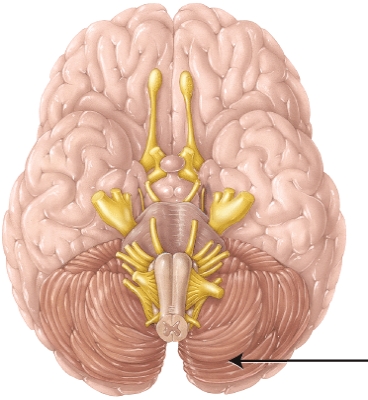
A) transverse fissure
B) longitudinal fissure
C) central sulcus
D) lateral sulcus

A) transverse fissure
B) longitudinal fissure
C) central sulcus
D) lateral sulcus

Unlock Deck
Unlock for access to all 75 flashcards in this deck.
Unlock Deck
k this deck
69
This structure is separated from the occipital lobe of the cerebrum by a fold of the dura mater referred to as the 
A) transverse fissure.
B) longitudinal fissure.
C) falx cerebri.
D) tentorium cerebelli.

A) transverse fissure.
B) longitudinal fissure.
C) falx cerebri.
D) tentorium cerebelli.

Unlock Deck
Unlock for access to all 75 flashcards in this deck.
Unlock Deck
k this deck
70
The structure indicated by the arrow is primarily involved with which of the following? 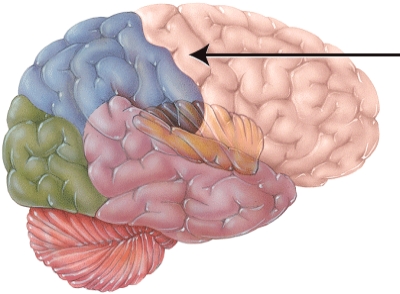
A) smell
B) vision
C) motor control
D) sensory perception

A) smell
B) vision
C) motor control
D) sensory perception

Unlock Deck
Unlock for access to all 75 flashcards in this deck.
Unlock Deck
k this deck
71
This structure is separated from the cerebellum by the 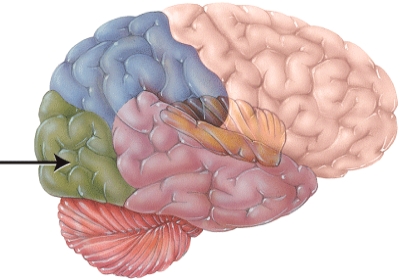
A) central sulcus.
B) transverse fissure.
C) longitudinal fissure.
D) falx cerebelli.

A) central sulcus.
B) transverse fissure.
C) longitudinal fissure.
D) falx cerebelli.

Unlock Deck
Unlock for access to all 75 flashcards in this deck.
Unlock Deck
k this deck
72
The structure indicated by the arrows is the 
A) cerebral peduncle
B) medullary pyramid
C) vermis
D) cerebellar peduncle

A) cerebral peduncle
B) medullary pyramid
C) vermis
D) cerebellar peduncle

Unlock Deck
Unlock for access to all 75 flashcards in this deck.
Unlock Deck
k this deck
73
What collection of commissural fibers is located deep in this structure? 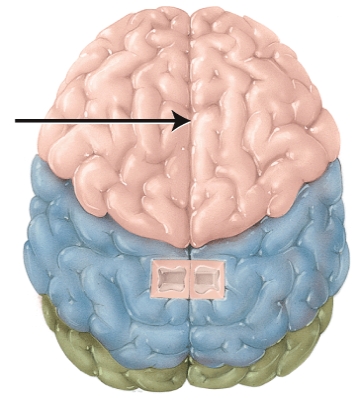
A) association tracts
B) corpus callosum
C) internal capsule
D) projections tracts

A) association tracts
B) corpus callosum
C) internal capsule
D) projections tracts

Unlock Deck
Unlock for access to all 75 flashcards in this deck.
Unlock Deck
k this deck
74
This structure sends information directly to the cerebellum via the _____ cerebellar peduncles. 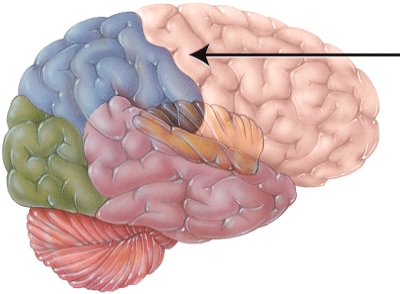
A) superior
B) middle
C) inferior

A) superior
B) middle
C) inferior

Unlock Deck
Unlock for access to all 75 flashcards in this deck.
Unlock Deck
k this deck
75
The primary _____ area is located here. 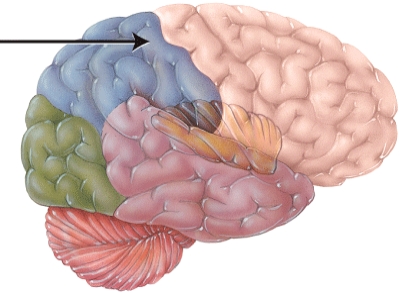
A) breathing
B) sensory
C) cardiovascular
D) speech

A) breathing
B) sensory
C) cardiovascular
D) speech

Unlock Deck
Unlock for access to all 75 flashcards in this deck.
Unlock Deck
k this deck



